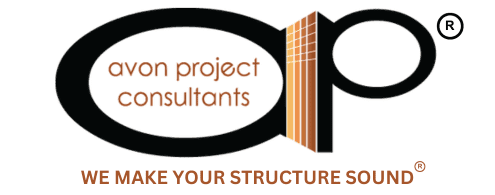Safeguard Your Building's Structural Integrity with Avon Project Consultants
Ensure the safety of your building with Avon Project Consultants comprehensive structural audits. Call us today for a free visit
What is a Structural Audit?
Structural audits are thorough examinations of a building’s health to safeguard its occupants. These mandatory assessments, conducted by licensed experts, identify areas requiring repair or replacement. Buildings between 15 and 30 years old require audits every five years, while those over 30 years need audits every three years. These durations start from the occupancy date or when 50% of the building is occupied. By embracing structural audits,
we can ensure safe and enduring structures.
Importance of Structural Audit
Structural audits are crucial for housing societies to ensure the safety and well-being of their residents. These audits assess the structural integrity of buildings, identifying any potential defects or weaknesses that could pose a risk. By conducting regular structural audits, societies can take proactive measures to address any issues and prevent accidents or collapses
Key Reasons for Structural Audit
Preventative Measures
Structural audits help identify potential problems early on, allowing for timely repairs and maintenance. This proactive approach prevents the escalation of minor issues into
major structural failures.
Enhanced Safety
By ensuring the stability of buildings, structural audits safeguard the lives of residents. Timely identification and rectification of structural defects minimize the risk of accidents and collapses.
Compliance with Regulations
In many regions, structural audits are mandatory for buildings exceeding a certain age or height. Societies must comply with these regulations to maintain legal standing and avoid potential penalties.
Increased Property Value
A well-maintained and structurally sound building holds higher property value. Regular structural audits demonstrate a society’s commitment to maintaining the building’s integrity, enhancing its attractiveness to potential buyers.
Peace of Mind
Structural audits provide peace of mind to residents, assuring them that their living spaces are safe and secure. This sense of security contributes to a more harmonious and stress-free living environment.
Frequency of Structural Audits
The frequency of structural audits depends on various factors, including the building’s age, type of construction,
and environmental conditions. Generally, it is recommended to conduct structural audits every 5 to 10 years for
older buildings and every 3 to 5 years for newer structures.
What Should Be Conducted During a Structural Audit?
A structural audit is a comprehensive assessment of the structural integrity of a building. It is conducted to identify any potential defects or weaknesses that could pose a risk to the safety of the building’s occupants. The specific procedures and methods used in a structural audit will vary depending on the type and size of the building, as well as the specific concerns of the building owner or property manager. However, some of the general procedures that are typically conducted during a structural audit include
Visual inspection:
This involves a thorough examination of the building’s exterior and interior, looking for any
signs of distress or damage. The inspector will pay particular attention to the foundations, walls, floors, roof,
and any other areas that are suspected of being weak or vulnerable
Non-destructive testing (NDT):
This involves using a variety of techniques to test the structural integrity of the building without damaging it.
- Rebound Hammer Test
- Ultrasonic Pulse Velocity Test
- Corrosion Test of Steel
- Carbonation Test
- Core Test
- Half-Cell Potentiometer Test
Review of structural drawings:
The inspector will review the building’s structural drawings to ensure that the building was designed and constructed properly. They will also check for any changes that have been made to the building since it was constructed
Analysis of structural data:
The inspector will use the data collected from the visual inspection, NDT, and review of structural drawings to analyze the structural integrity of the building. They will consider factors such as the building’s design, the materials used, and the loading conditions to determine whether the building is safe
Choosing the Right Structural Auditor
When selecting a structural auditor, societies should exercise due diligence and consider the following factors:
Experience
Choose an auditor with a proven track record of conducting thorough and accurate structural assessments, particularly for buildings similar to theirs
Qualifications
Ensure the auditor is licensed and possesses the necessary qualifications and certifications to perform structural audits.
Reputation
Seek recommendations from other societies or organizations that have engaged the auditor’s services.
Communication
Choose an auditor who can clearly explain the findings of the audit report and
provide recommendations in a comprehensible manner.
Building Structural Audits and PMC Services
Structural audits are essential for ensuring the safety and longevity of buildings. These comprehensive assessments evaluate the structural integrity of a building, identifying any potential defects or weaknesses that could pose a risk. PMC (Project Management consultants) services play a crucial role in overseeing the planning, execution, and completion of repair and maintenance projects, ensuring that work is done to the highest standards. Building Structural Audits and PMC Services. call Avon Projects Consultants –+91 9967504207 /+91 9987244208
Book a Free Visit
Our Featured Works
SEAWOODS ESTATE Phase-1
(SEAWOOD)
Patel Heritage CHSL
(Kharghar)
Twins Tower
(Kharghar)
Kesar Garden
(Kharghar)
Kesar Harmony
(Kharghar)
Golden Willows
(Mulund West)
Hawa Mahal CHS
(Thane West)
Happy Vally Phase1
(Thane West)
SEAWOODS ESTATE Phase-1
(SEAWOOD)
Patel Heritage CHSL
(Kharghar)
Twins Tower
(Kharghar)
Kesar Garden
(Kharghar)
Kesar Harmony
(Kharghar)
Golden Willows
(Mulund West)
Twins Tower
(Kharghar)
Happy Vally Phase1
(Thane West)
Our Achievments
AVON PROJECTS CONSULTANTS ®
We are a team of experienced Civil Engineers and Architects, and we provide a complete repairs and Rehabilitation solution for various problems based in your Buildings.
Quick links
Structural Auditor
Our Achievments
Have questions, comments or just want to say hello:
- avonprojectscon@gmail.com
-
+91 9967504207
+91 9987244208
- D/12, Plot No. 28, Jay Shree Krishna CHSL, Mhada Colony, Mulund (E) Mumbai - 400081
